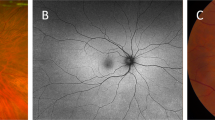Abstract
Background/Objective
Asteroid hyalosis (AH) is an uncommon clinical entity of unknown aetiology that is associated with older age. Previous epidemiologic studies have reported various systemic and demographic risk factors for AH but remain limited due to regional constraints of their study populations. Additionally, Hispanic and Non-Hispanic black populations remain under sampled. The aim of this study is to examine the prevalence of asteroid hyalosis in the United States and identify associated factors at a national level.
Subjects/Methods
This is a population-based, cross-sectional study of 5578 subjects aged 40 and older from the 2005 to 2008 National Health and Nutrition Examination Survey (NHANES). The primary outcome measured was asteroid hyalosis on retinal imaging in any eye. Evaluated risk factors included patient demographics, medical history, body measures, serum markers, and fundus photography findings.
Results
Prevalence of asteroid hyalosis was 0.86% overall, 0.86% in Caucasians, 0.79% in African-Americans, and 0.88% in Hispanics. Asteroid hyalosis was associated with older age (p < 0.0001, 95% confidence interval [CI], 0.06–0.12; odds ratio [OR], 1.09) but not ethnicity or sex. After adjusting for age, greater bodyweight (p = 0.049; 95% CI, 0.001–0.04; OR, 1.02), and history of myocardial infarction (p = 0.022; 95% CI, 0.07–1.55; OR, 2.36) were also found to be significant risk factors.
Conclusion
Asteroid hyalosis is a rare entity in the US associated with older age, greater body weight, and prior history of MI. A potential relationship between AH and cardiovascular disease remains plausible.
This is a preview of subscription content, access via your institution
Access options
Subscribe to this journal
Receive 18 print issues and online access
$259.00 per year
only $14.39 per issue
Buy this article
- Purchase on Springer Link
- Instant access to full article PDF
Prices may be subject to local taxes which are calculated during checkout
Similar content being viewed by others
Data availability
The dataset analysed during the current study are available in the NHANES repository [https://www.cdc.gov/nchs/nhanes/index.htm].
References
Khoshnevis M, Rosen S, Sebag J. Asteroid hyalosis-a comprehensive review. Surv Ophthalmol. 2019;64:452–62. https://doi.org/10.1016/j.survophthal.2019.01.008
Mishra C, Tripathy K. Asteroid Hyalosis. [Updated 2021 Aug 21]. In: StatPearls [Internet]. (Treasure Island (FL): StatPearls Publishing, 2021) https://www.ncbi.nlm.nih.gov/books/NBK554375/
Kim JH, Roh MI, Byeon SH, Koh HJ, Lee SC, Kwon OW. Prevalence of and risk factors for asteroid hyalosis in Seoul, Korea. Retin (Phila, Pa). 2008;28:1515–21. https://doi.org/10.1097/IAE.0b013e318185ea3c
Mitchell P, Wang MY, Wang JJ. Asteroid hyalosis in an older population: The Blue mountains eye study. Ophthalmic Epidemiol. 2003;10:331–5. https://doi.org/10.1076/opep.10.5.331.17324
Moss SE, Klein R, Klein BE. Asteroid hyalosis in a population: The Beaver Dam eye study. Am J Ophthalmol. 2001;132:70–75. https://doi.org/10.1016/s0002-9394(01)00936-9
Fawzi AA, Vo B, Kriwanek R, Ramkumar HL, Cha C, Carts A, et al. Asteroid hyalosis in an autopsy population: The University of California at Los Angeles (UCLA) experience. Arch Ophthalmol (Chic, Ill: 1960). 2005;123:486–90. https://doi.org/10.1001/archopht.123.4.486
Møller-Lorentzen TB, Eckmann-Hansen C, Faber C, Larsen M, Subhi Y. Global prevalence of asteroid hyalosis and projection of its future burden: A systematic review and meta-analysis. Acta ophthalmologica. 2020;98:755–62. https://doi.org/10.1111/aos.14465
Mather M, Jacobsen L, Pollard M. Aging in the United States. Population Bulletin, 2015;70. https://www.prb.org/resources/fact-sheet-aging-in-the-united-states/
Bergren RL, Brown GC, Duker JS. Prevalence and association of asteroid hyalosis with systemic diseases. Am J Ophthalmol. 1991;111:289–93. https://doi.org/10.1016/s0002-9394(14)72311-6
Jervey ED, Anderson WB Jr. Asteroid Hyalitis: A study of serum calcium levels in affected patients. South Med J. 1965;58:191–4. https://doi.org/10.1097/00007611-196502000-00010
Centers for Disease Control and Prevention (CDC). National Center for Health Statistics (NCHS). National Health and Nutrition Examination Survey Questionnaire (or Examination Protocol, or Laboratory Protocol) (2021). https://wwwn.cdc.gov/nchs/nhanes/analyticguidelines.aspx
Khan SS, Ning H, Wilkins JT, Allen N, Carnethon M, Berry JD, et al. Association of Body Mass Index With Lifetime Risk of Cardiovascular Disease and Compression of Morbidity. JAMA Cardiol. 2018;3:280–7. https://doi.org/10.1001/jamacardio.2018.0022
Cupples LA, Gagnon DR, Wong ND, Ostfeld AM, Kannel WB. Preexisting cardiovascular conditions and long-term prognosis after initial myocardial infarction: The Framingham Study. Am Heart J. 1993;125:863–72. https://doi.org/10.1016/0002-8703(93)90182-9
Winkler J, Lünsdorf H. Ultrastructure and composition of asteroid bodies. Investigative Ophthalmol Vis Sci. 2001;42:902–7.
Reid IR, Birstow SM, Bolland MJ. Calcium and cardiovascular disease. Endocrinol Metab (Seoul, Korea). 2017;32:339–49. https://doi.org/10.3803/EnM.2017.32.3.339
Kalampogias A, Siasos G, Oikonomou E, Tsalamandris S, Mourouzis K, Tsigkou V, et al. Basic mechanisms in Atherosclerosis: The role of calcium. Medicinal Chem (Shariqah (U Arab Emirates)). 2016;12:103–13. https://doi.org/10.2174/1573406411666150928111446
Cockburn DM. Are vitreous asteroid bodies associated with diabetes mellitus? Am J Optom physiological Opt. 1985;62:40–44. https://doi.org/10.1097/00006324-198501000-00005
Acknowledgements
The authors would like to acknowledge Sreekanth Mallikarjun, whose tireless support and generosity of data science expertise made this paper possible. The authors would also like to acknowledge Mary Qiu, for sharing her expertise in teaching and epidemiological research, and for providing inspiration for this work.
Author information
Authors and Affiliations
Contributions
Contributors RD devised the study, collected data, contributed to the analysis, discussion, main interpretation of results and writing of the manuscript. XC collected data, contributed to the analysis, discussion, main interpretation of results and writing of the manuscript. NA collected data, contributed to the analysis, discussion, main interpretation of results, and writing of the manuscript. ES devised the study, collected data, contributed to the analysis, discussion, main interpretation of results, and writing of the manuscript. RS devised the study, collected data, contributed to the analysis, discussion, main interpretation of results, and writing of the manuscript.
Corresponding author
Ethics declarations
Competing interests
The authors declare no competing interests.
Additional information
Publisher’s note Springer Nature remains neutral with regard to jurisdictional claims in published maps and institutional affiliations.
Rights and permissions
About this article
Cite this article
Duong, R., Cai, X., Ambati, N. et al. Prevalence of asteroid hyalosis and systemic risk factors in United States adults. Eye 37, 1678–1682 (2023). https://doi.org/10.1038/s41433-022-02214-z
Received:
Revised:
Accepted:
Published:
Issue Date:
DOI: https://doi.org/10.1038/s41433-022-02214-z



